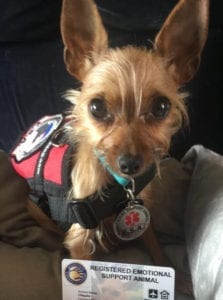May I be of assistance?
This week, we take a moment to recognize all the devoted, hardworking assistance dogs all over the world. International Assistance Dog Week is August 5-11.
There is a lot of misinformation out there about what an assistance dog really is. And it doesn’t help when people try to pass off their unruly pets as accredited service dogs. News stories abound about fake service dogs disrupting restaurants, retail stores and airlines, attacking people and actual service dogs, pooping all over and being a general nuisance. It doesn’t help that service dog vests, leashes and cards are available for purchase by anyone online. Dogs exhibiting poor manners or training do nothing to help the legitimacy of true service dogs.
So, we answer the burning question… What do service dogs really do?
The most important role these dogs play is as companions, aides, best friends and close members of the family.
Some are guide dogs, assisting people with vision loss, leading them around physical obstacles and to places such as seating, crossing streets, doorways, elevators and stairs. Some are hearing alert dogs, helping people with hearing loss to the presence of specific sounds such as door bells, telephones, crying babies, sirens, door knocks, smoke, fire and clock alarms. Some respond to certain medical conditions, such as heart attack, stroke, diabetes, epilepsy, panic or anxiety attack, PTSD and seizures. Others assist with walking, balance, dressing, retrieving and carrying items, opening doors and drawers, pushing buttons, pulling wheelchairs and removing clothes from the washer and dryer.
Service dogs must have spot on obedience skills. They must also have countless hours of socialization and public access training; and hundreds, even thousands of hours of specialized rigorous training relating to the duties needed by their disabled partner. Fake service dogs chip away at the credibility of accredited service dogs. They undermine the trust that the public has in the service dog’s credentials and makes it difficult for the dog and its human to function as a team.
In the United States, service dogs are covered by the Americans with Disabilities Act. According to the ADA, there are two questions that staff may ask when someone comes into their establishment with a service dog: (1) is the dog a service animal required because of a disability? And, (2) what work or task has the dog been trained to perform. They are not allowed to ask what that person’s disability is and they are not allowed to ask the dog perform tasks to prove their training.
Therapy dogs usually do have some training, but unlike service dogs, who are trained to assist one person, therapy dogs are trained to interact with lots of people. They often work in nursing homes and with children. Emotional support dogs provide a calming presence or companionship for their owner’s but aren’t always trained in basic obedience.
Therapy and emotional support dogs are not covered by the Americans with Disabilities Act, although that does not diminish the important role they play in the lives of their human partners.
All three types of dogs come into our hospital for veterinary care, each with their own special gifts. We have their photos on our wall of honor in our reception area and love each of them equally.
To learn more about service dogs or how to acquire one, please visit Canine Companions for Independence http://www.cci.org/, Indiana Canine Assistance Network http://www.icandog.org/, 1Pet1Vet https://www.1pet1vet.com/, or Northern Indiana Service Dogs http://www.northernindianaservicedogs.com/

